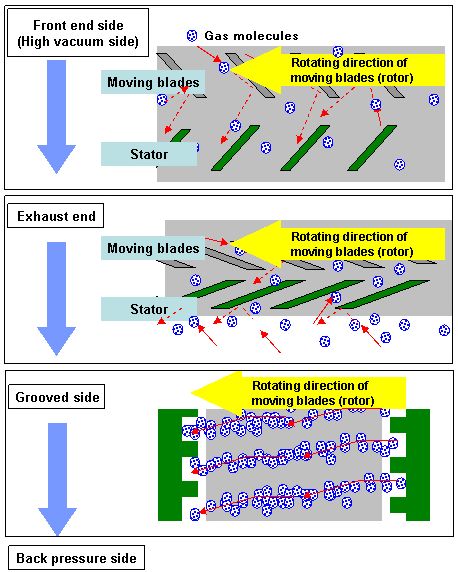Product Search
Turbo Molecular Pumps
Turbo molecular pumps consist of moving and stator blades arranged on multiple levels. The figure below shows the relation between the angle and rotating direction of the blades. Gas molecules inbound from the high vacuum side enter the moving blades and try to exit in various directions. However, the angle and rotation of the blades cause the molecules to move toward the exhaust end and through the quickest path in the stator. Gas molecules that flow back from the rearmost stage through the stator hit the moving blade, sending them back to the exhaust end.
Turbo Molecular Pumps (Compound Molecular Pumps) Exhaust Theory
Turbo molecular pumps consist of moving and stator blades arranged on multiple levels. The figure below shows the relation between the angle and rotating direction of the blades. Gas molecules inbound from the high vacuum side enter the moving blades and try to exit in various directions. However, the angle and rotation of the blades cause the molecules to move toward the exhaust end and through the quickest path in the stator. Gas molecules that flow back from the rearmost stage through the stator hit the moving blade, sending them back to the exhaust end. The blades are angled on the front end to facilitate passage of gaseous molecules (where the difference between the flow to and from the exhaust is greater), whereas on the exhaust end, the blades are angled to hinder passage (where the ratio between the flow in the exhaust direction and against it is greater). In the area of molecular flow, the moving blade and stator perform the basic functions of the turbo molecular pump.
Osaka Vacuum added a threaded groove to the moving blade and stator blade combination. The walls of the cylindrical rotor drag the gas molecules along the threaded groove in the stator, delivering them to the back pressure side. The functionality of the threaded groove enabled us to develop a turbo molecular pump (compound molecular pump) capable of exhausting large flow volumes, particularly in medium flow ranges in addition to the molecular flow range. This expanded the operating range for turbo molecular pumps which are now used in a wide variety of applications. And its ability to operate under high back pressure has widened the choices for auxiliary pumps.

Typical Benefits of the Turbo Molecular Pump
- Provides an oil-free ultra-high vacuum.
- It features roughly the same exhaust rate for all gases in order to mechanically exhaust parentheses (dynamically exhaust) gas molecules.
- It can also exhaust noble and corrosive gases.
- It can continually exhaust large flow volumes of gas.
- Wide working pressure range (to 10-10Pa).
